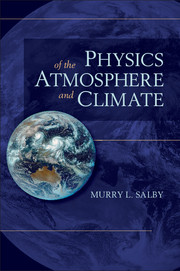Book contents
- Frontmatter
- Contents
- Preface
- Prelude
- 1 The Earth-atmosphere system
- 2 Thermodynamics of gases
- 3 The Second Law and its implications
- 4 Heterogeneous systems
- 5 Transformations of moist air
- 6 Hydrostatic equilibrium
- 7 Static stability
- 8 Radiative transfer
- 9 Aerosol and cloud
- 10 Atmospheric motion
- 11 Atmospheric equations of motion
- 12 Large-scale motion
- 13 The planetary boundary layer
- 14 Wave propagation
- 15 The general circulation
- 16 Dynamic stability
- 17 Influence of the ocean
- 18 Interaction with the stratosphere
- Appendix A Conversion to SI units
- Appendix B Thermodynamic properties of air and water
- Appendix C Physical constants
- Appendix D Vector identities
- Appendix E Curvilinear coordinates
- Appendix F Pseudo-adiabatic chart
- Appendix G Acronyms
- Answers to selected problems
- References
- Index
- Plate section
3 - The Second Law and its implications
Published online by Cambridge University Press: 05 June 2012
- Frontmatter
- Contents
- Preface
- Prelude
- 1 The Earth-atmosphere system
- 2 Thermodynamics of gases
- 3 The Second Law and its implications
- 4 Heterogeneous systems
- 5 Transformations of moist air
- 6 Hydrostatic equilibrium
- 7 Static stability
- 8 Radiative transfer
- 9 Aerosol and cloud
- 10 Atmospheric motion
- 11 Atmospheric equations of motion
- 12 Large-scale motion
- 13 The planetary boundary layer
- 14 Wave propagation
- 15 The general circulation
- 16 Dynamic stability
- 17 Influence of the ocean
- 18 Interaction with the stratosphere
- Appendix A Conversion to SI units
- Appendix B Thermodynamic properties of air and water
- Appendix C Physical constants
- Appendix D Vector identities
- Appendix E Curvilinear coordinates
- Appendix F Pseudo-adiabatic chart
- Appendix G Acronyms
- Answers to selected problems
- References
- Index
- Plate section
Summary
The First Law of Thermodynamics describes how the state of a system changes in response to work that it performs and heat that it absorbs. The Second Law of Thermodynamics deals with the direction of thermodynamic processes and the efficiency with which they occur. Because these characteristics control how a system evolves out of a given state, the Second Law also governs the stability of thermodynamic equilibrium.
NATURAL AND REVERSIBLE PROCESSES
A process for which the system can be restored to its initial state without leaving a net influence on the system or on its environment is said to be reversible. A reversible process is actually an idealization: a process that is free of friction and for which changes of state occur slowly enough for the system to remain in thermodynamic equilibrium. By contrast, a natural process is one that proceeds spontaneously. It can be stimulated by an infinitesimal perturbation. Because the system is then out of thermodynamic equilibrium with its surroundings, a natural process cannot be reversed entirely, namely, without leaving a net influence on either the system or its environment. A natural process is therefore inherently “irreversible.”
Irreversibility arises whenever the system is out of thermodynamic equilibrium. This occurs during rapid changes of state. Performing work across a finite pressure difference, wherein the system is out of mechanical equilibrium, is irreversible. So is transferring heat across a finite temperature difference, wherein the system is out of thermal equilibrium.
- Type
- Chapter
- Information
- Physics of the Atmosphere and Climate , pp. 95 - 111Publisher: Cambridge University PressPrint publication year: 2012



